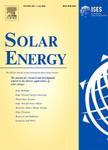版权所有:内蒙古大学图书馆 技术提供:维普资讯• 智图
内蒙古自治区呼和浩特市赛罕区大学西街235号 邮编: 010021

作者机构:Khalifa Univ Masdar Inst Solar Platform Mech & Nucl Engn Dept POB 127788 Abu Dhabi U Arab Emirates Khalifa Univ Ind & Syst Engn Dept POB 127788 Abu Dhabi U Arab Emirates Khalifa Univ Res Labs POB 127788 Abu Dhabi U Arab Emirates ENOWA NEOM Energy Div Flexibil Team NEOM Gayal Saudi Arabia
出 版 物:《SOLAR ENERGY》 (Sol. Energy)
年 卷 期:2025年第287卷
核心收录:
学科分类:0820[工学-石油与天然气工程] 080703[工学-动力机械及工程] 08[工学] 0807[工学-动力工程及工程热物理]
基 金:Khalifa University [CIRA 847000414] ASPIRE, the technology program management pillar of Abu Dhabi's Advanced Technology Research Council (ATRC) , via the ASPIRE VRI (Virtual Research Institute) [VRI20-07]
主 题:Concentrated solar thermal systems Heat flux measurement Indirect method Calorimeter Heat flux gauge
摘 要:Concentrated solar thermal (CST) systems, capable of driving high-temperature processes up to 2000 K, hold significant potential for chemical and industrial applications. This paper reviews methods for measuring concentrated solar flux, focusing on their role in calculating key optical performance metrics such as concentration ratio and optical efficiency. It also explores the challenges associated with these measurements. Flux measurement methods are categorized into direct and indirect approaches. Direct methods use heat flux gauges positioned on a stationary or moving target to measure solar flux, while indirect methods rely on a CCD or CMOS camera, a Lambertian target, and a heat flux gauge. The camera captures images of solar radiation, which are calibrated to heat flux values using readings from the heat flux gauge. Heat flux gauges are a critical component of both direct and indirect measurement methods. This study also reviews and compares various types of heat flux gauges, including Gardon radiometers, Schmidt-Boelter gauges, Kendall radiometers, heat flux microsensors, and calorimeters. The comparison considers factors such as maximum flux rating, response time, durability, water-cooling requirements, cost, and measurement uncertainty. Calibration techniques for these gauges are also discussed. It is observed that indirect methods are commonly used for measuring concentrated solar flux due to their higher resolution, which enables them to identify hot spots and measure concentrated solar flux more accurately than direct methods. The key challenges in measuring concentrated solar flux include calibrating sensors under solar conditions, ensuring sensor durability, accounting for environmental factors, and managing cost considerations.